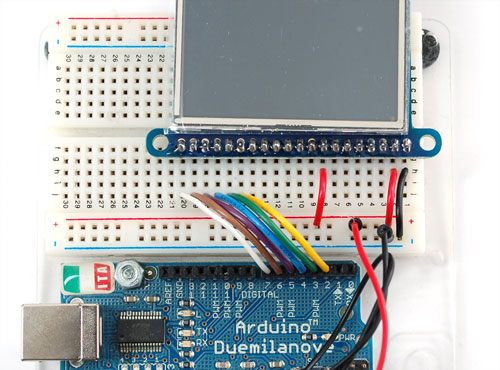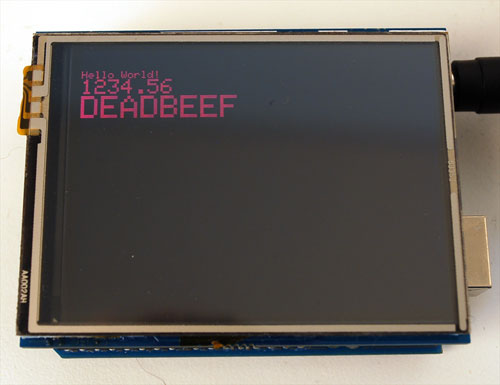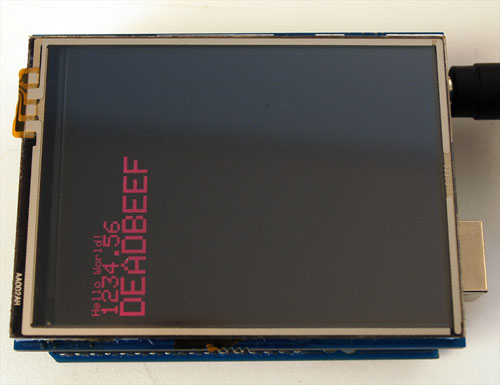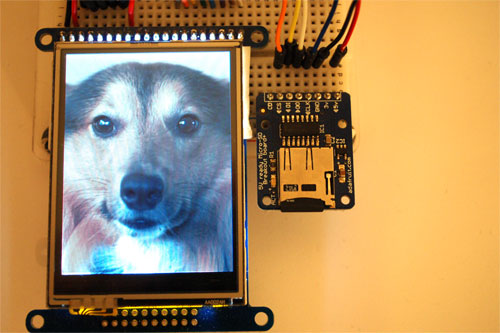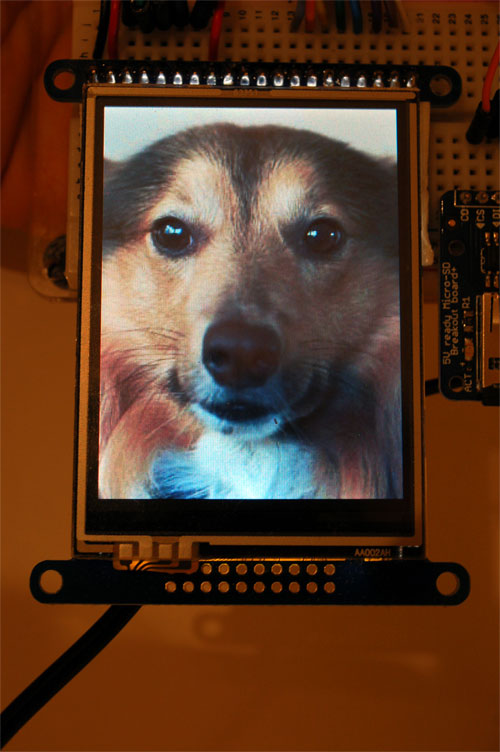Table of Contents
2.8" TFT LCD with Touchscreen
Add some jazz & pizazz to your project with a color touchscreen LCD. This TFT display is big (2.8" diagonal) bright (4 white-LED backlight) and colorful (16-bit 262,000 different shades)! 240x320 pixels with individual pixel control, this has way more resolution than a black and white 128x64 display. As a bonus, this display has a resistive touchscreen attached to it already, so you can detect finger presses anywhere on the screen.
This display has a controller built into it with RAM buffering, so that almost no work is done by the microcontroller. You'll need 8 digital data lines and 4 or 5 digital control lines to read and write to the display (12 lines total). 4 pins are required for the touch screen (2 digital, 2 analog) but because of the way resistive touch screens work, we can share pins with the LCD so the entire setup can be run by 12 pins (10 digital, 2 analog).
Of course, we wouldn't just leave you with a datasheet and a "good luck!" - we've written a full open source graphics library that can draw pixels, lines, rectangles, circles and text. We also have a touch screen library that detects x, y and z (pressure) and example code to demonstrate all of it. The code is written for Arduino but can be easily ported to your favorite microcontroller!
Pick one up today at the Adafruit Shop!
Specifications:
- 2.8" diagonal LCD TFT display
- 240x320 resolution, 16-bit (262,000) color
- ILI9325 (datasheet) or ILI9328 (datasheet) controller with built in video RAM buffer
- 8 bit digital interface, plus 4 or 5 control lines
- 5V compatible! Use with 3.3V or 5V logic
- Onboard 3.3V @ 150mA LDO regulator
- 4 white LED backlight, transistor connected so you can PWM dim the backlight
- 1x20 header for easy breadboarding, or 2x10 header for cable connection
- 4 x 0.125"/3mm mounting holes with tabs
Connection options
The TFT LCD requires a lot of pins to use with your processor. We have two breakouts available which you can use depending on your application.
The first (right hand side) is a single 1x20 header strip with 0.1" spacing. This is perfect for breadboard use or if you have to do some hand wiring. You can use 'straight' header or 'right angle' header so that it stands up straight (although it may be harder to touch if its soldered this way)
To solder the header, we suggest placing a 20pin strip of header, long pins down into a breadboard.
Place the LCD on top and solder each pin.
The second is a 2x10 dual header strip with 0.1" spacing. This is perfect for use with an IDC cable for remote access. We suggest a 6" cable but you might be able to use a 12" one, it depends on how fast you're writing to the screen (faster means a shorter cable required).
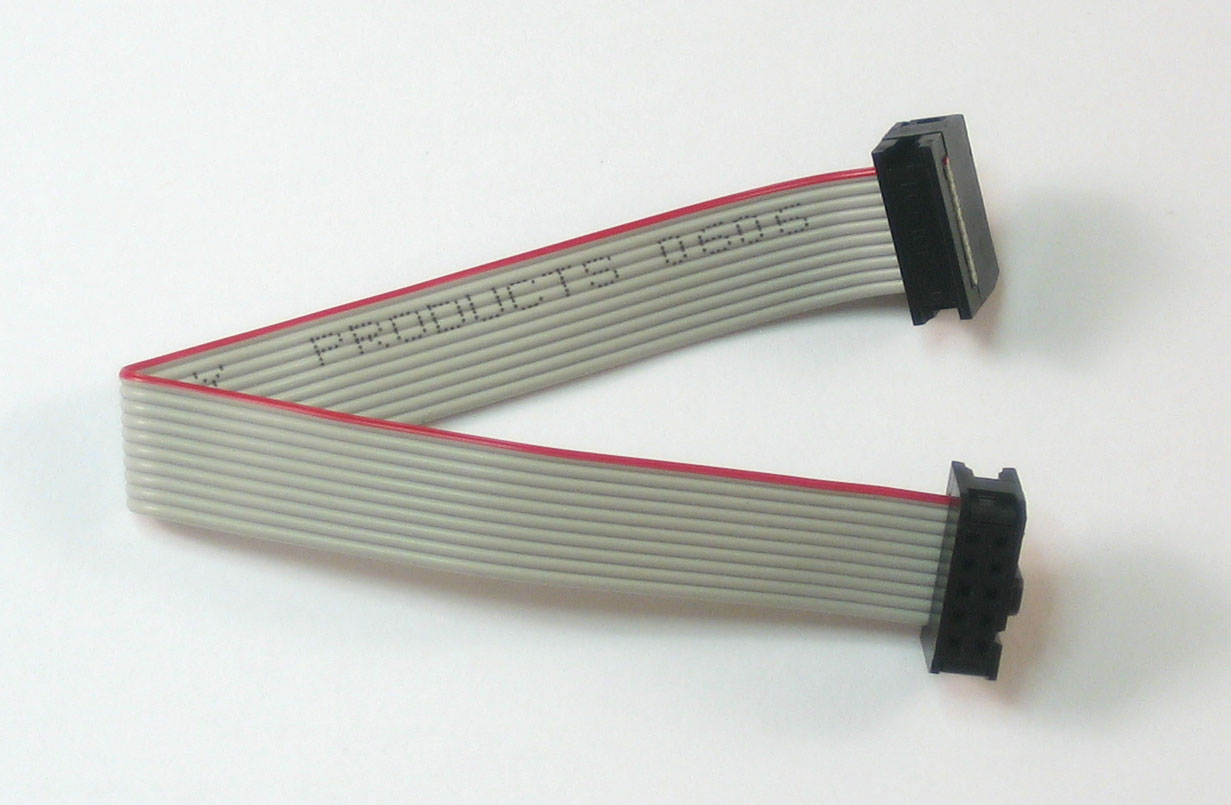
This cable is a 2x5 not 2x10 but its what the larger cable will look like
Mounting options
We wanted to make sure that you could easily put this display in a box. There are four mounting holes on tabs. If you really don't need the tabs they can be cut off with a hacksaw or tin-snips. The holes are 2.25" apart in the short direction and 2.95" apart in the long direction. The drill holes are 0.125" and will easily take a #4 imperial or M3 (3mm) screw. The PCB is 0.063" thick
Backlight wiring
There are three basic 'components' to the LCD.
The backlight is the first. It is made of 4 white LEDs in parallel with a transistor to control them. The LEDs can draw as much as 80mA all together, but you can PWM the backlight to dim it - the transistor makes it easy to connect any kind of microcontroller output. You can also connect the backlight pin directly to a 3 or 5V pin to turn it on all the way.
We'll begin by assuming you'll be using the 1x20 connector and an Arduino. Wiring may be different for your microcontroller
Start by connecting the first pin Ground of the LCD to ground and the second pin 3-5V to 5V (you can use 3-5V, this pin will power the TFT and backlight so be sure it can supply 100mA). Then skip 5 pins and connect pin #8 Backlite to 5V
Power up your set, and you'll see the 4 white LED backlight. If this isn't working, something is amiss with your power supply. Go back and fix the wiring!
TFT wiring
Now that the backlight is working, we can get the TFT LCD working. There are many pins required, and to keep the code running fairly fast, we have 'hardcoded' Arduino digital pins #2-#9 for the 8 data lines
Start at the end of the TFT (other side than the power pins) and in order connect the pins to digital 7 thru 2. If you're using a mega, connect the TFT Data Pins #0-7 to Mega pins #22-29, in that order. Those Mega pins are on the 'double' header
Then connect the next two pins to digital 9 and 8
If you're using a mega, connect the TFT Data Pins #0-7 to Mega pins #22-29, in that order. Those Mega pins are on the 'double' header
In addition to the 8 data lines, you'll also need 4 or 5 control lines.
- Connect the third pin CS (Chip Select) to Analog 3
- Connect the fourth pin C/D (Command/Data) to Analog 2
- Connect the fifth pin WR (Write) to Analog 1
- Connect the sixth pin RD (Read) to Analog 0
Now we can run some code!
LCD Test
We have example code ready to go for use with these TFTs. It's written for Arduino, which should be portable to any microcontroller by adapting the C++ source.
Two libraries need to be downloaded and installed: first is the TFTLCD library (this contains the low-level code specific to this device), and second is the Adafruit GFX Library (which handles graphics operations common to many displays we carry). Download both ZIP files, uncompress and rename the folders to 'Adafruit_TFTLCD' and 'Adafruit_GFX' respectively, place them inside your Arduino libraries folder and restart the Arduino IDE. If this is all unfamiliar, we have a tutorial introducing Arduino library concepts and installation.
After restarting the Arduino software, you should see a new example folder called Adafruit_TFTLCD and inside, an example called graphicstest. Upload that sketch to your Arduino. You may need to press the Reset button to reset the arduino and TFT. You should see a collection of graphical tests draw out on the TFT
Now you know everything is working. If you're having problems, check the serial port monitor. The first thing the sketch does is read the driver code from the TFT. It should be 0x9328 or 0x9325 so if you see something like 0x8328 that means that the D8 pin is not wired correctly and if you get 0x9228 then pin D0 is not wired correctly. Remember that the two bytes are read one after another.
Graphics library
The graphics library has a few ready to go functions that should help you start out with your project. Its not exhaustive and we'll try to update it if we find a really useful function.
First thing to note is that color is 16-bit, and that includes Red, Green and Blue in a 16-bit variable. The way the color is packed in is the top 5 bits are red, the middle 6 bits are green and the bottom 5 bits are blue.
For solid colors, we have this handy cheat-sheet. Of course, you can pick any of 262,000 colors but while starting out, this might be helpful
// Color definitions #define BLACK 0x0000 #define BLUE 0x001F #define RED 0xF800 #define GREEN 0x07E0 #define CYAN 0x07FF #define MAGENTA 0xF81F #define YELLOW 0xFFE0 #define WHITE 0xFFFF
First up is the most basic pixel pusher. You can call this with two coordinates and a color and it will make a dot:
void drawPixel(uint16_t x, uint16_t y, uint16_t color);
You can also draw lines, with a starting and end point and color
void drawLine(uint16_t x0, uint16_t y0, uint16_t x1, uint16_t y1, uint16_t color);
If your lines are vertical or horizontal, you can call an optimized drawing function that doesn't do all the angular calculations.
void drawVerticalLine(uint16_t x0, uint16_t y0, uint16_t length, uint16_t color); void drawHorizontalLine(uint16_t x0, uint16_t y0, uint16_t length, uint16_t color);
Next up, rectangles and squares can be drawn and filled using the following procedures. If you want a recangle that has a contrasting outline color, fillRect first, then drawRect over it
void drawRect(uint16_t x0, uint16_t y0, uint16_t w, uint16_t h, uint16_t color); void fillRect(uint16_t x0, uint16_t y0, uint16_t w, uint16_t h, uint16_t color);
Likewise, for circles, you can draw and fill
void drawCircle(uint16_t x0, uint16_t y0, uint16_t r, uint16_t color); void fillCircle(uint16_t x0, uint16_t y0, uint16_t r, uint16_t color);
Text is a little different. Instead of one procedure, you will set up the text size, color and location and then print() (just like Serial.print()!)
void setCursor(uint16_t x0, uint16_t y0); void setTextColor(uint16_t color); void setTextSize(uint8_t size);
First start with setCursor(x, y) this will place the top right corner of the text where-ever you please. Initially, its set to (0, 0). Then set the text color with setTextColor(color) by default its white. Then set the 'size' with setTextSize(size) this will 'multiply' the text by a scaling factor. Above you can see scales of 1 (default), 2 and 3. This is because we only ship the library with a simple font, to save space. You can just scale it to get bigger text without requiring a new font.
Finally, you can use print() or println() just like you do with Serial! For example, to print a string, use print("Hello world") - that's the first line of the image above. To print variables, you can also use print() the second line is print(1234.56) and the third line is print(0xDEADBEEF, HEX)
You can also rotate your drawing. Note that this will not rotate what you already drew, but it will relocate any new drawing.
void rotate(uint8_t rotation);
The rotation variable can be 0, 1, 2 or 3. Rotation 0 makes it so that the display is in portrait mode, with the USB jack in the top right. Rotation 2 is portrait, with the USB jack in the bottom left. Rotation 1 is landscape mode, with the USB jack in the bottom right and rotation 3 is also landscape, with the USB jack in the top left.
When you rotate, the origin point moves with you. You may need to reference the size of the screen, which changes between portrait and landscape, use width() and height()! To get the size.
uint16_t width(); uint16_t height();
These primitives should get you started!
Touchscreen
The LCD has a 2.8" 4-wire resistive touch screen glued onto it. You can use this for detecing finger-presses, stylus', etc. You'll need 4 pins to talk to the touch panel but you can reuse some of the pins for the TFT LCD! This is because the resistance of the panel is high enough that it doesn't interfere with the digital input/output and we can query the panel in between TFT accesses, when the pins are not being used.
You can wire up the 4 remaining pins as follows. the one on the very left (Y- orange) can connect to digital 9, the next one over (X- green) connects to Analog 2, The next one over (Y+ blue) connects to Analog 3 and the last one (X+ gray) connects to digital 8. The X- and Y+ pins pretty much have to connect to those analog pins (or to analog 4/5) but Y-/X+ can connect to any digital or analog pins.
Now start up the tftpaint example in the Arduino library. The right hand side will have 'color boxes' you can press to select which color you want to draw with. If you press the area to the left where the screen ends, it will erase the screen.
You can use your fingertip to draw
If you press the area to the left where the screen ends, it will erase the screen.
Bitmaps
We have an example sketch in the library showing how to display full color bitmap images stored on an SD card. You'll need an SD or microSD breakout board such as this one. You'll also need to download our SD library modifyied to allow faster reads (these changes will be added to arduino v23) but for now you can download the new library here. Download the library by clicking the Downloads button and uncompressing the folder. Replace the files in your ArduinoIDE/libraries/SD folder and restart the IDE.
Wire up the TFT as we have before (see above) and then wire up the microSD card breakout. Connect the SD card with DI going to pin 11, DO going to pin 12 and SCK going to pin 13 (this is standard on all our shields) Then pin 10 goes to CS. Copy the woof.bmp and miniwoof.bmp files to a microSD card and insert it into the breakout. Run the tftbmp example sketch in the TFTLCD library, you should see the images show up. If not, check the serial monitor for hints as to why it may not be working











